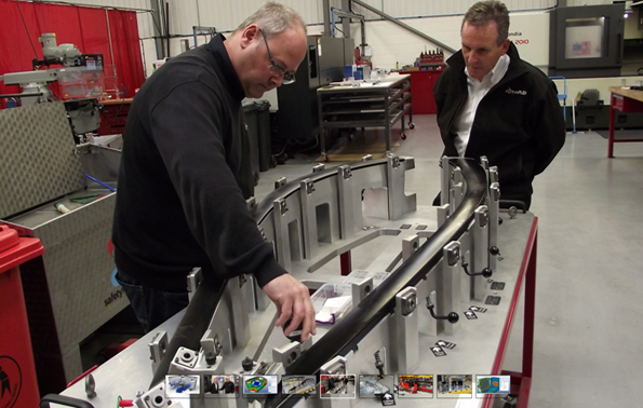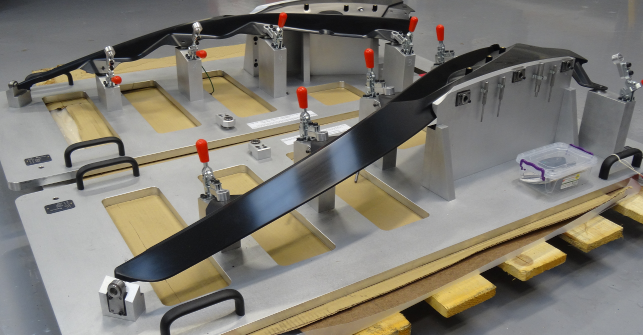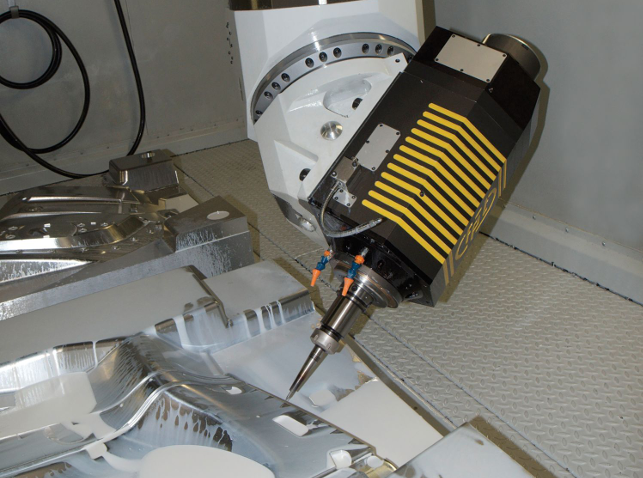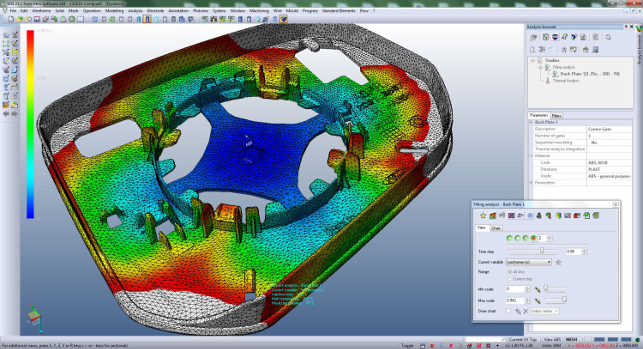
Specialist engineering manager Grant Keates (left) discusses a finer point of an automotive fixture with technical director Adrian Chapman
With operations spread across 150,000 square feet in three state-of-the-art sites in Hampshire, UK, and a new 120,000 purpose built site set to come online in 2016, Formaplex can boast an impressively wide range of business activities.
The company designs and manufactures aluminium and steel injection mould tools for the automotive, motorsports and aerospace industries. It produces low volume finished moulded components, from brackets and fixings to bumper assemblies and instrument panels. And it also supplies composite tooling and components and carries out specialist machining and finishing projects, component painting, flocking and assembly.
All that calls for a wide armoury of tools. The company has over 40 CNC machines, both 3- and 5-axis, offering a range of machining envelopes up to 8m x 6.2m x 2m, to suit a wide variety of design projects. Its capabilities are further supported by 11 injection mould presses, from 55 tonnes to 3,500 tonnes.

VISI helps Formaplex create bespoke fixtures for their inspection process, ensuring absolute accuracy and repeatable tolerances
Formaplex technical director Adrian Chapman says the company’s strengths lie in being able to provide full design support and advice for tools, covering areas as diverse as plastic flow analysis, logistics project management, production, measurement, tool testing, design and manufacture.
In order to ensure the long-lasting integrity of the company’s mould tools, Formplex relies on VISI Flow from Vero Software.
The injection simulation capabilities provided by the package, says Chapman, help the company to achieve cost-effective and reliable designs and optimum moulding conditions, such as well-balanced runners with symmetrical filling patterns, for example.
“Aluminium moulds, in particular, can be damaged if filled from the wrong position, in the wrong sequence or by excessive pressure with inadequate clamp tonnage,” he explains.

Working on a mould tool with a Dinox drill
“It’s all too easy to blow the mould and damage the parting faces. But VISI Flow shows us all potential manufacturing issues such as welding lines, air traps and the best gate location, before the mould is trialled.”
“We can quickly analyse where the pressure will be too high, whether the material will freeze too quickly, if we need to have more than one gate and whether they’re in the right place,” he continues. “Once we’ve analysed and understood exactly what we need to do, we can advise the customer on necessary changes such as part-thickness modification, changing the material or re-engineering.”
Initial studies of moulded features and draft check analysis tell Chapman all he needs to know to complete his initial Design for Manufacturability (DFM) work. He then carries out initial fill studies, where VISI provides the same level of control over injecting molten polymer into the mould cavity as is available on the moulding machine itself.
The simulation then provides the ability to forecast and visualise how a component will be filled by the plastic melt front, making it possible to identify any potential aesthetic issues.
VISI Flow provides a number of analytical tools that allow the investigation of moulding variables such as pressure, temperature, shear stress, frozen skin, fibre orientation, clamping force and others.
“With VISI, I can quickly analyse the customer CAD data to verify moulding feasibility by checking for draft conditions and undercut features; then VISI Flow shows the capability of successfully moulding the required plastic part,” he says.
“We use the part splitting tools to create parting faces, enabling us to quickly design the main core and cavity block. Once we have those finalised, we model the sliders, lifters and any other small components – whether they’re automatic or manual – and incorporate them into the mould tool.
With VISI, Chapman and his team can simulate the mould kinematics and correct any issues before they start cutting expensive metal.
“It gives a very clear indication of all areas where problems could arise. We can give our customers full and accurate information regarding the development of their mould tools. Without it, our dynamic approach and customer service would definitely be hindered.”
Once the mould tool is complete, it undergoes a maturation procedure – a series of process trials that monitor and review the continuous improvement of the product until the component is ultimately accepted.
A crucial part of the Formaplex business is its Specialist Engineering division, which supports the Metrology Department. Here, moulded components are accurately inspected and measured with the latest CMM technology.
Formaplex designs and manufactures bespoke fixtures for the inspection process, under the guidance of specialist engineering manager Grant Keates.
VISI plays a key role in this process, too, according to Keates, by ensuring absolute accuracy and repeatable tolerances. He says his team designs the fixture by importing the native CAD model into VISI and creating the fixture around the critical points of the component.

VISI Flow analyses filling patterns and maximises process parameters
“The CAD data can come from our customers in a range of formats, but VISI handles it all seamlessly, which is a great advantage for our speed and efficiency of design.”
The next step is to send the finished CAD data of the fixture to the shop floor, where VISI Machining’s dedicated high-speed milling techniques and built-in smoothing algorithms create intelligent 3- and 5-axis toolpaths for the company’s Doosan and Kondia CNC machines.
“We don’t have any real challenges or issues with designing and manufacturing our jigs and fixtures, because VISI helps us achieve everything we need to.”
The Specialist Engineering division at Formaplex is keen to embrace new technology and is investing heavily year on year. It is now able to offer sheet metal fabrication, too, encompassing a wide range of steels, as well as more exotic metals such as titanium.
Summing up the company’s overall experience of using VISI, Adrian Chapman says: “It provides us with key information at the design stage and it supports the complete mould process, which ultimately ensures total end product satisfaction.”
“A conservative estimate is that, within the first month of using VISI Flow to analyse the correct filling pattern and maximise our process parameters, we saved the cost of the software by avoiding downtime, repairs, wasted toolmaking and setting time and reduced material costs.”
VISI Flow mould injection simulation software pays dividends for Formaplex
Default






